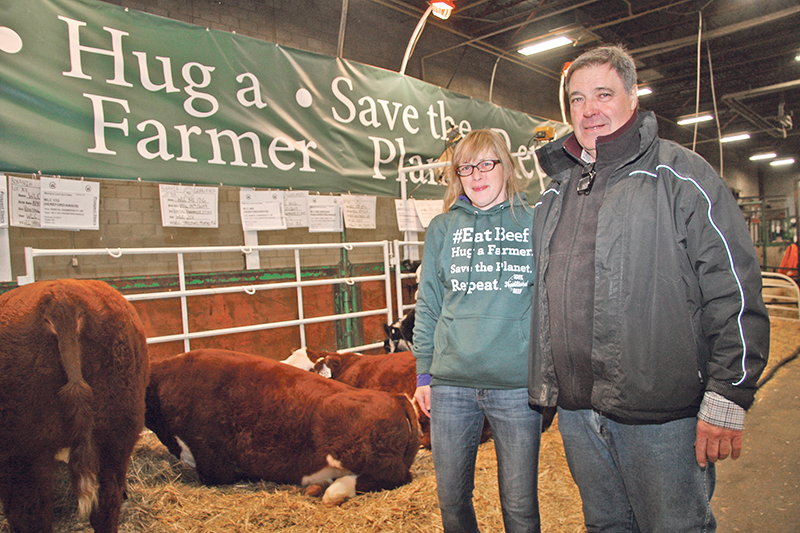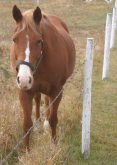A farm couple wants the industry to talk up the benefits of grazing for the environment and the healthy aspects of beef
REGINA — During the week of Canadian Western Agribition, a green and white banner caught the eye of many that passed. It announced: Eat beef. Hug a farmer. Save the planet. Repeat.
The concept comes from Tom and Danika Warnyca of Montmartre, Sask., who were inspired to praise their industry as they listened to activists criticize the cattle business for doing environmental harm and mistreating animals.
A nutritionist who fell in love with a cowboy, Danika said she took the time to learn about the beef industry and is becoming one of its defenders.
Read Also

Beef check-off collection system aligns across the country
A single and aligned check-off collection system based on where producers live makes the system equal said Chad Ross, Saskatchewan Cattle Association chair.
“We are under attack,” she said at the Warnyca family stall, where they were selling prospect steers to juniors and 4-H members.
She wants the Canadian industry to talk up the benefits of grazing for the environment and the healthy aspects of beef. She wants people to know cattle are humanely raised in an environment that preserves diversity and habitat.
“I am a firm believer in the good our national herd is doing with the grasslands, with cellular grazing, with the 68 percent of the wildlife that graze with them. That is our goal. People don’t understand,” she said.
Part of their campaign is to promote and sell their home-raised beef labelled 100 percent traditional.
“Canadian beef is the healthiest, most nutritious product there is on the face of the Earth. It has been raised responsibly from the beginning to the end. All we have done is refine it and decide what we think is important,” Tom said.
A former registered Polled Hereford breeder, he dispersed the herd nearly 20 years ago and kept commercial cattle. The beef program is focused on producing a different kind of beef using Angus-, Hereford- and Galloway-cross cattle.
“You have to be very disciplined when you are a seedstock producer. We are using our bloodlines and our individual herd bulls that are probably better than when we were seedstock producers,” he said.
His experience as a seedstock producer taught him the value of carefully selected bloodlines, record keeping and accountability.
The cattle live on pasture and are finished on home grown peas and oats. The beef is processed at a provincial plant, although they would like to find a federally inspected facility so they could sell the beef nationally and spread their sustainability message.
Tom wants sturdy, functional cattle that produce finely textured, tasty beef.
They had the meat tested so they can add a nutrition panel to show protein percentages, cholesterol and fat levels including a percentage of omega 3 and 6 fatty acids.
The beef program starts with Tom selecting the best genetics he can find.
The Galloway base started in 2010 with a bull purchased from retiring breeder Robert Ballintine. They bought an older herd sire named Diamond B Mozart 16M and were able to produce a line of the Scottish cattle.
They maintain control on care and production from start to finish to maintain the British base.
British cattle were raised for beef production whereas many of the European Continental breeds were dual or triple purpose. Many were used as draft animals and they evolved in a different direction from the traditional British beef types.
The Galloway are hardy, sound cattle and moderate sized. Because of the longer hair coat they do not need a thick layer of outer fat for warmth and energy.
The cattle destined for processing are usually about a quarter Galloway. The carcasses are bit smaller than commodity beef but they marble well and have less outer fat.
Keen to meet their customers, they ran an in-store survey and offered taste testing where they sold their beef. Those interviewed said their top consideration in buying beef was taste, followed by humane treatment of the animals, nutritional profile, cost and the environmental impact.
Besides offering succulent beef, they have designed their program with complete traceability so they can tell customers which animals produced the beef.
“People want to know where their food is coming from and they want to know how it was treated,” Danika said.
Tom added: “There is a shift more toward that. If more people know about these fake meat products that are coming out and learn how unhealthy they are, if we can offer them an alternative that is reasonable and makes sense and is nutritious and checks all the boxes, I think they will pay for it.”


















